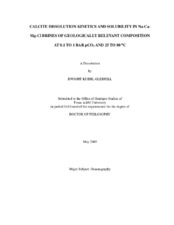| dc.description.abstract | Sedimentary basins can contain close to 20% by volume pore fluids that are commonly classified as brines. These fluids can become undersaturated with respect to calcite as a result of processes such as migration, dispersive mixing, or anthropogenic injection of CO2. This study measured calcite solubility and dissolution rates in geologically relevant Na-Ca-Mg-Cl synthetic brines (35 to 200 g L-1 TDS). In brines < 50 g L-1 TDS, the EQPITZER calculated calcium carbonate ion activity product (IAP) at steady-state was in reasonable agreement (±10%) with the thermodynamic solubility constant for calcite (Kc). However, the IAP systematically exceeded Kc in more concentrated brines. The deviation was strongly correlated with calcium concentration and also was observed in magnesium-free solutions. This is interpreted as an uncertainty in the carbonate ion activity coefficient, and minor adjustment in stoichiometric association constants (K*M2+CO30) for the CaCO30 or MgCo30 ion pairs would correct for the error. The dissolution rate dependency on brine composition, pCO2 (0.1 to 1 bar), and temperature (25.0 to 82.5 °C) was modeled using the empirical rate equation ()nkRΩ−=1 where R is the rate, k and n are empirical fitting terms, and Ω the degree of disequilibrium with respect to calcite. When Ω was defined relative to an apparent kinetic solubility, n could be assumed first-order over the range of Ω investigated (Ω = 0.2 to 1.0). Rates increased with increasing pCO2 as did the sensitivity to brine concentration. At 0.1 bar, rates were nearly independent of concentration (k = 13.0 ±2.0 x 10-3 moles m-1 hr-1). However, at higher CO2 partial pressures rates became composition dependent and the rate constant, k, was shown to be a function of temperature, pCO2, ionic strength, and calcium and magnesium activity. The rate constant (k) can be estimated from a multiple regression (MR) model of the form k = B0 + B1(T) + B2(pCo2) + B4(aCa2+) + B5(aMg2+). A relatively high activation energy (Ea = 20 kJ mol-1) was measured, along with a stirring rate independence suggesting the dissolution is dominated by surface controlled processes at saturation states Ω > 0.2 in these calcium-rich brines. These findings offer important implications to reaction-transport models in carbonate-bearing saline reservoirs. | en |


